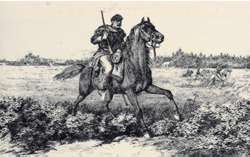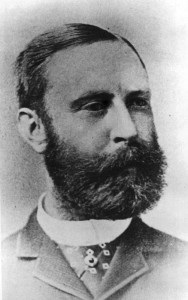Search:
results for ‘kelly's ford’
143 years ago today, an epic passage of arms occurred on the hills and fields surrounding an obscure stop on the Orange & Alexandria Railroad called Brandy Station, located a few miles from Culpeper Court House. 21,000 Union and Confederate cavalrymen and 3,000 Union infantrymen spent fourteen hours locked in mortal combat that day.
The Union commander, Brig. Gen. Alfred Pleasonton, the temporary commander of the Army of the Potomac’s Cavalry Corps, was given a simple task: fall upon, destroy, or disperse the huge concentration of Confederate cavalry in Culpeper County. Pleasonton designed a brilliant plan. He divided his force into two wings. The right wing, consisting of the First Cavalry Division and a brigade of 1,500 selected infantry, would …
In addition to being St. Patrick’s Day, today also marks the 143rd anniversary of the Battle of Kelly’s Ford, fought on March 17, 1863, along the banks of the chilly Rappahannock River.
On February 24, 1863, Confederate Brig. Gen. Fitz Lee, under orders to find the end of the Union line, led a raid of 500 hand-picked troopers of his brigade on the far right flank of the Army of the Potomac at Hartwood Church. Marching forty miles across country in deep snow, Fitz’s men launched a vicious dawn surprise attack that scattered the Federal cavalry pickets. Lee’s men chased them until they came under the guns of the 124th New York Infantry. Having found the Federal infantry, Fitz broke …
A Brief History of Union Cavalry in the Eastern Theatre of the Civil War up to The Battle of Gettysburg
Civil War armies consisted of three major components: infantry, artillery, and cavalry. Cavalry played a major role. It’s primary role was to support the infantry and artillery, gathering intelligence, scouting, screening the movements of the army, and serving as the “eyes and ears of the army”. As the war dragged on, the Federal cavalry’s role changed. Instead of scouting and screening, the primary role became that of an offensive weapon. By the end of the Civil War, the Northern cavalry had become one of the most fearsome offensive forces that the world had ever seen.
 In 1861, with the coming …
In 1861, with the coming …
 This is another forgotten cavalrymen profile that I’ve been working on for a while. This one features Maj. Jerome B. Wheeler, a man who led a fascinating life and who ultimately became both benefactor and scoundrel at the same time.
This is another forgotten cavalrymen profile that I’ve been working on for a while. This one features Maj. Jerome B. Wheeler, a man who led a fascinating life and who ultimately became both benefactor and scoundrel at the same time.
Jerome B. Wheeler was born in Troy, New York on September 3, 1841, the son of Daniel Barker Wheeler and Mary Jones Emerson. On his father’s side, he could trace his ancestry to British barons, while his mother was a cousin of Ralph Waldo Emerson. Both of his parents were originally from Massachusetts. The family moved to Waterford, New York while Wheeler was a boy, where he attended public schools until the age of 15. In 1856, he took a …









 Back to top
Back to top Blogs I like
Blogs I like 